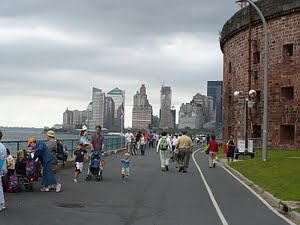New York City is one of the most visited tourist spots in the world. With over 8 million residents, it is the most populous city in the United States. With more than 45 million visitors per year, the center of the world is a myriad of endless experiences. For anyone planning on visiting New York, there are several important basics of navigating the metropolis.
Basic New York Geography
New York City is made up of five boroughs, or counties: the Bronx, Brooklyn, Manhattan, Queens, and Staten Island. The Bronx is the only borough attached to the mainland. It’s the northernmost part of the city. (It’s also the only part of New York City that’s referred to with an article…as New Yorkers would say it, “Da” Bronx.) Queens and Brooklyn lie to the east of Manhattan and make up the western portion of Long Island. Manhattan is an island in the center of New York Harbor. Staten Island is another island further south in New York harbor.
Manhattan Island
When one conjures up thoughts of New York City, what they’re really thinking of is the island of Manhattan. All o f the other boroughs have their own unique flavor and character, but Manhattan is the epicenter of the metropolis and is where most of the major attractions are located.
Manhattan is extremely easy to navigate, as long as you can count. Houston Street is sort of an unofficial border between the south side of the city, which contains such famed neighborhoods as Chinatown, Little Italy, and Wall Street, and the rest of the metropolis. From Houston Street northward, Manhattan is a grid divided into streets, running east and west, and avenues, going north to south. The area known as Lower Manhattan, south of Houston Street is not a part of a grid system, so it can be more confusing to get around.
The first street north of Houston of course, is First Street, then Second and Third, and so on. The streets are relatively short in comparison to the avenues, most of which stretch from the uppermost portions of Manhattan to the south. The Avenues are a set up a little differently, with a couple of non-numbered roads thrown in for confusion. Beginning from the east side is First Avenue, followed by Second, Third, Lexington (Fourth), Park, Madison, Fifth, Sixth (Avenue of the Americas), Seventh, Eighth, Ninth, and Tenth Avenues, Eleventh and Twelfth Avenues. Broadway runs diagonally throughout the city, beginning at the northern tip of Manhattan running southbound to Battery Park at the southern tip of the island.
“Squares” dot the city at certain points where Broadway crosses an avenue. There’s Union Square at Broadway and 14th Street, Herald Square at Broadway and 34th, and Times Square at Broadway and 42nd, among others. Squares are generally shopping havens and thus centers of high concentrations of people. Times Square is the living, breathing heart of New York and is home to the famed theaters of Broadway.
All the streets and avenues in Manhattan alternate in traffic flow direction. The traffic on First Avenue runs northbound, Second Avenue runs southbound, and so on. Park Avenue is the only avenue with two-way traffic and Broadway runs southbound. The streets that run east-west also alternate in traffic direction, with the exceptions of several streets, including 14th Street, 23rd Street, 34th, etc., which are two-way.
Getting around
The Metropolitan Transit Authority (MTA) provides bus and subway service throughout the Manhattan and the outer boroughs, with the exception of Staten Island. Bus routes vary throughout the city and are good for localized destinations. Taxis are plentiful for getting to one’s destination more directly, albeit at a higher cost.
Subway lines run generally north-south along Lexington and Eighth Avenues, and Broadway. East-west trains can be caught on 14th, 42nd, 53rd, and 59th Streets. Since the avenues are much longer than the streets, it’s best to use the north and southbound trains to get around to different parts of the city, and walk east or west once you get to near your desired location. The cost of a single subway or bus ride is $2.25, and discounts are available using the Metrocard, which can be purchased in various increments at many locations throughout the city.
Clearly, New York City is a big place that can be intimidating to a first time visitor. It was designed however, in a simple way that makes getting around relatively simple.
For Subway and bus information, see the MTA website:
http://www.mta.info/index.html

